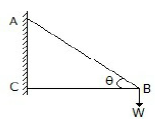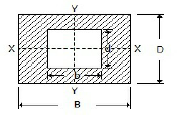Coefficient of friction is the
Angle between normal reaction and the resultant of normal reaction and the limiting friction
Ratio of limiting friction and normal reaction
The friction force acting when the body is just about to move
The friction force acting when the body is in motion
Correct Answer :
B. Ratio of limiting friction and normal reaction
Related Questions
In determining stresses in frames by methods of sections, the frame is divided into two parts by an imaginary section drawn in such a way as not to cut more than
Two members with unknown forces of the frame
Three members with unknown forces of the frame
Four members with unknown forces of the frame
Three members with known forces of the frame
Effect of a force on a body depends upon
Magnitude
Direction
Position or line of action
All of the above
The linear acceleration (a) of a body rotating along a circular path of radius (r) with an angular acceleration of α rad/s2, is
a = α/ r
a = α.r
a = r / α
None of these
Moment of inertia is the
Second moment of force
Second moment of area
Second moment of mass
All of these
The product of either force of couple with the arm of the couple is called
Resultant couple
Moment of the forces
Resulting couple
Moment of the couple
Three forces acting on a rigid body are represented in magnitude, direction and line of action by the three sides of a triangle taken in order. The forces are equivalent to a couple whose moment is equal to
Area of the triangle
Twice the area of the triangle
Half the area of the triangle
None of these
Two non-collinear parallel equal forces acting in opposite direction
Balance each other
Constitute a moment
Constitute a couple
Constitute a moment of couple
The equivalent length of a simple pendulum which gives the same frequency as compound pendulum is
h/(kG² + h²)
(kG² + h²)/h
h²/(kG² + h²)
(kG² + h²)/h²
Which of the following do not have identical dimensions?
Momentum and impulse
Torque and energy
Torque and work
Moment of a force and angular momentum.
A cable with a uniformly distributed load per horizontal meter run will take the following shape
Straight line
Parabola
Hyperbola
Elliptical
Efficiency of a screw jack is given by (where α = Helix angle, and φ = Angle of friction.)
tan(α + φ)/tanα
tanα/tan (α + φ)
tan(α - φ)/tanα
None of these
An ideal machine is one whose efficiency is
Between 60 and 70 %
Between 70 and 80 %
Between 80 and 90 %
100 %
The C.G. of a solid hemisphere lies on the central radius 3r
At distance from the plane base 3r
At distance from the plane base 3r
At distance from the plane base 3r
At distance from the plane base
Which of the following statement is correct?
The algebraic sum of the forces, constituting the couple is zero
The algebraic sum of the forces, constituting the couple, about any point is the same
A couple cannot be balanced by a single force but can be balanced only by a couple of opposite sense
All of the above
Coulomb friction is the friction between
Bodies having relative motion
Two dry surfaces
Two lubricated surfaces
Solids and liquids
The three forces of 100 N, 200 N and 300 N have their lines of action parallel to each other but act in the opposite directions. These forces are known as
Coplanar concurrent forces
Coplanar non-concurrent forces
Like parallel forces
Unlike parallel forces
A framed structure, as shown in the below figure, is a 
Perfect frame
Deficient frame
Redundant frame
None of the above
From a circular plate of diameter 6 cm is cut out a circle whose diameter is a radius of the plate. Find the e.g. of the remainder from the centre of circular plate
0.5 cm
1.0 cm
1.5 cm
2.5 cm
Which of the following is a vector quantity?
Energy
Mass
Momentum
Angle
The force induced in the string AB due to the load W, as shown in the below figure is 
W sinθ
W cosθ
W secθ
W cosecθ
The static friction
Bears a constant ratio to the normal reaction between the two surfaces
Is independent of the area of contact, between the two surfaces
Always acts in a direction, opposite to that in which the body tends to move
All of the above
The unit of force in S.I. units is
kilogram
Newton
Watt
Dyne
The energy possessed by a body, for doing work by virtue of its position, is called
Potential energy
Kinetic energy
Electrical energy
Chemical energy
The process of finding out the resultant force is called __________ of forces.
Composition
Resolution
Decomposition
None of these
If a rigid body is in equilibrium under the action of three forces, then
These forces are equal
The lines of action of these forces meet in a point
The lines of action of these forces are parallel
Both (B) and (C) above
Moment of inertia of a hollow rectangular section as shown in the below figure about X-X axis, is 
(BD³/12) - (bd³/12)
(DB³/12) - (db³/12)
(BD³/36) - (bd³/36)
(DB³/36) - (db³/36)
The algebraic sum of the resolved parts of a number of forces in a given direction is equal to the resolved part of their resultant in the same direction. This is known as
Principle of independence of forces
Principle of resolution of forces
Principle of transmissibility of forces
None of these
The length of a second's pendulum is
94.9 cm
99.4 cm
100 cm
101 cm
The motion of a wheel of a car is
Purely translation
Purely rotational
Combined translation and rotational
None of these
The C.G. of a right circular solid cone of height h lies at the following distance from the base
h/2
J/3
h/6
h/4
